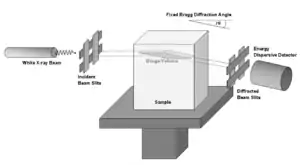Energy-dispersive X-ray diffraction
Energy-dispersive X-ray diffraction (EDXRD) is an analytical technique for characterizing materials. It differs from conventional X-ray diffraction by using polychromatic photons as the source and is usually operated at a fixed angle.[1] With no need for a goniometer, EDXRD is able to collect full diffraction patterns very quickly. EDXRD is almost exclusively used with synchrotron radiation which allows for measurement within real engineering materials.[2]


History
EDXRD was originally proposed independently by Buras et al. and Giessen and Gordon in 1968.[3]
Advantages
The advantages of EDXRD are (1) it uses a fixed scattering angle, (2) it works directly in reciprocal space, (3) fast collection time, and (4) parallel data collection. The fixed scattering angle geometry makes EDXRD especially suitable for in situ studies in special environments (e.g. under very low or high temperatures and/or pressures). When the EDXRD method is used, only one entrance and one exit window are needed. The fixed scattering angle also allows for measurement of the diffraction vector directly. This allows for high-accuracy measurement of lattice parameters. It allows for rapid structure analysis and the ability to study materials that are unstable and only exist for short periods of time. Because the whole spectrum of diffracted radiation is obtained simultaneously, it enables parallel data collection studies where structural changes can be determined over time.
Facilities
| Facility | Location | Beamline | Energy range (keV) |
|---|---|---|---|
| National Synchrotron Light Source | Upton, NY | X17B1[4] | 50–200 |
| Advanced Photon Source | Argonne, IL | 16-BM-B[5] | 10–120 |
| German Electron Synchrotron | Hamburg, DE | P61B[6] | 50-150 |
| Cornell High Energy Synchrotron Source | Ithaca, NY | B1[7] | unknown |
| Diamond Light Source | Oxfordshire, UK | I12[8] | 50–150 |
| SOLEIL | Paris, France | I03c[9] | 15–100 |
| Indus 2 | India | BL-11[10] | unknown |
References
- Kämpfe, B.; Luczak, F.; Michel, B. (2005). "Energy Dispersive X-Ray Diffraction". Part. Part. Syst. Charact. 22 (6): 391–396. doi:10.1002/ppsc.200501007. S2CID 97000421. Retrieved March 16, 2014.
- "Energy Dispersive Diffraction". Diamond Light Source. Retrieved March 17, 2014.
- Laine, E.; Lähteenmäki, I. (February 1980). "The energy dispersive X-ray diffraction method: annotated bibliography 1968–78". Journal of Materials Science. 15 (2): 269–277. Bibcode:1980JMatS..15..269L. doi:10.1007/BF02396775. S2CID 189834585.
- "Beamline X17B1". Brookhaven National Laboratory. Archived from the original on March 18, 2014. Retrieved March 17, 2014.
- "Beamline 16-BM-B: Sector 16 – Bending Magnet Beamline". Argonne National Laboratory. Archived from the original on March 18, 2014. Retrieved March 17, 2014.
- "P61B Large Volume Press (DESY)". Helmholtz Association. Retrieved December 16, 2022.
- "CHESS West – B1". Cornell University. Retrieved March 17, 2014.
- "I12: Joint Engineering, Environmental, and Processing (JEEP)". Diamond Light Source. Retrieved March 17, 2014.
- "PSICHÉ beamline". Synchrotron SOLEIL – L'Orme des Merisiers Saint-Aubin. Retrieved March 17, 2014.
- Pandey, K. K.; et al. (April 2013). "Energy-dispersive X-ray diffraction beamline at Indus-2 synchrotron source". Pramana. 80 (4): 607–619. Bibcode:2013Prama..80..607P. doi:10.1007/s12043-012-0493-0. S2CID 122303528.
 | This template does not display in the mobile view of Wikipedia; it is desktop only. Read the documentation for an explanation. |
This is a navigational template created using {{navbox}}. It can be transcluded on pages by placing {{Energy-dispersive X-ray diffraction}} below the standard article appendices.
Initial visibility
This template's initial visibility currently defaults to autocollapse, meaning that if there is another collapsible item on the page (a navbox, sidebar, or table with the collapsible attribute), it is hidden apart from its title bar; if not, it is fully visible.
To change this template's initial visibility, the |state= parameter may be used:
{{Energy-dispersive X-ray diffraction|state=collapsed}}will show the template collapsed, i.e. hidden apart from its title bar.{{Energy-dispersive X-ray diffraction|state=expanded}}will show the template expanded, i.e. fully visible.
TemplateData
A navigational box that can be placed at the bottom of articles.
| Parameter | Description | Type | Status | |
|---|---|---|---|---|
| State | state | The initial visibility of the navbox
| String | suggested |
Template transclusions
| Transclusion maintenance |
|---|
| Check completeness of transclusions |